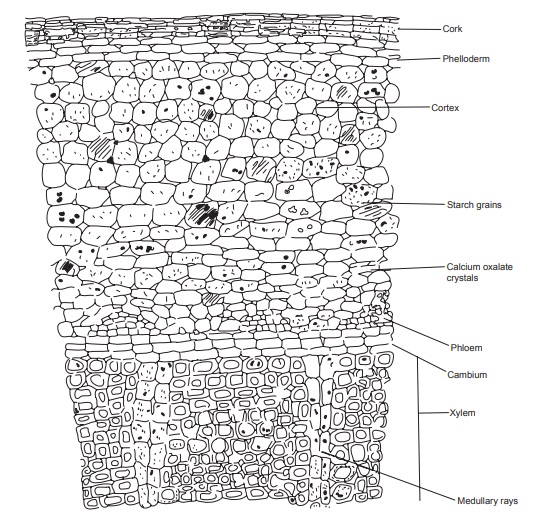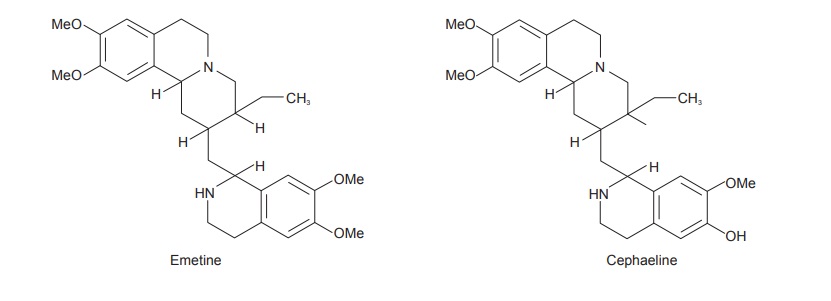Ipecac
| Home | | Pharmacognosy |Chapter: Pharmacognosy and Phytochemistry : Drugs Containing Alkaloids
Ipecac consists of the dried root or rhizome of Cephaelis ipecacuanha (Brot.) A. Rich. (Rio or Brazilian Ipecac) or of Cephaelis acuminata Karst. (Cartagena, Nicaragua or Panama Ipecac), belonging to family Rubiaceae. It should contain about 2% of ether soluble alkaloids calculated as emetine.
IPECAC
Synonyms
Ipecacuanha; Brazilian or Johore Ipecac; Hippo; Ipecacuanha
root; Radix ipecacuanhae.
Biological Source
Ipecac consists of the dried root or rhizome of Cephaelis ipecacuanha (Brot.) A. Rich. (Rio or Brazilian Ipecac) or of Cephaelis
acuminata Karst. (Cartagena, Nicaragua or Panama Ipecac), belonging to
family Rubiaceae. It should contain about 2% of ether soluble alkaloids
calculated as emetine.
Geographical Source
The plant is indigenous to Brazil and also found in
Colombia, Cartagena, Nicaragua, Savantilla, Malaya, Burma, Panama and West
Bengal. In India it is cultivated at Mungpoo (Darjeeling), in Nilgiris near
Collar and in Sikkim.
Cultivation and Collection
The plant is a low, straggling shrub containing slender
rhizome with annulated wiry roots. The roots are smooth, slender and whitish
when young, develop on maturation a thick brownish bark with numerous closely
placed trans-verse furrows.
The plant is unusually slow growing. It thrives best in
forest areas on sandy loams in humus, potash, magnesia and lime. A maximum
rainfall of 90 inch is required throughout the year. A temperature between 15
and 40°C and shaded situations are essential for successful cultivation.
Temperature fluctuations should be narrow and the soil should be well drained.
Propagation is by stem or root cuttings planted about a foot apart each way.
Roots are harvested when the plants are about 2.5 years old and the alkaloid
content exceeds 20%. The plant may be dug up at any time of the year; the roots
are washed and dried in shade.
Characteristics
The rhizome is thin or sometimes thick and annulated. Rhio
Ipecac is 5–15 cm long, 6 mm in diameter, shape is cylindrical, slightly,
tortuous, external surface is broadly annulated, brick red to brown in colour,
the ridges are rounded and encircle the root, fracture of root is short and
shows a thick, greyish bark and small dense wood. Odour is slight and taste is
bitter and acrid.
Cartagena Ipecac is 4–6.5 mm in diameter, greyish-brown in
colour, less crowded and less projecting annulations, has transverse ridges.
Half of the portion contains bark.
The Matto Grosso drug occurs in tortuous pieces, up to 15 cm
long and 6 mm diameter. The colour of the outer surface varies from a deep
brick-red to a very dark brown; the colour is dependent on the type of soil in
which the plant has been grown. Most of the roots are annulated externally, and
some have a portion of the rhizome and nonannulated roots are also found. The
ridges are rounded and completely encircle the root; in some parts the bark has
completely separated from the wood.
The fracture shows a thick greyish bark and a small, dense
wood, but no pith. The rhizomes have a much thinner bark and definite pith.

Microscopy
A transverse section of the root shows a thin, brown cork,
the cells of which contain brown, granular material. There is wide, secondary
cortexes (phelloderm), the cells of which are parenchymatous and contain starch
in compound grains with from two to eight components, or raphides of calcium
oxalate. The individual starch grains are muller-shaped. The phloem is
parenchymatous, containing no sclerenchymatous cells or fibres. The compact
central mass of xylem is composed of small tracheidal vessels, tracheids,
substitute fibres, xylem fibres and xylem parenchyma. Starch is present in the
xylem parenchyma and in substitute fibres. The transverse section of
ipecacuanha rhizome shows a ring of xylem and large pith. The pericycle
contains characteristic sclerenchymatous cells. Spiral vessels occur in the protoxylem.
The pith is composed of pitted lignified parenchyma.

Chemical Constituents
Ipecac root contains 2–3% of total alkaloids. These include
emetine, cephaeline, psychotrine and psychotrine methyl ether. All the
alkaloids have isoquinoline ring system and, are present in the bark. Emetine
is the active alkaloid and as it does not contain a free phenolic group it is
called nonphenolic alkaloid. Emetine base is noncrystalline but its salts are
crystalline, Rio ipecac contains slightly more than 2% alkaloids from which
emetine are two-thirds and cephaeline is one-third. In Cartagena ipecac,
alkaloids are up to 2.2% and emetine is about one-third and cephaeline
two-thirds. The other alkaloids are in traces.

Chemical Test of Emetine
Powdered drug (0.5 g) is mixed with HCl (20 ml) and water (5
ml), filtered and to the filtrate (2 ml) potas-sium chloride (0.01) is added.
If emetine is present, a yellow colour develops which on standing for 1 hour
gradually changes to red.
Uses
Ipecac is emetic and used as an expectorant and diaphoretic
and in the treatment of amoebic dysentery. The alkaloids have local irritant
action. Emetine has a more expectorant and less emetic action than cephaeline.
In the treatment of amoebic dysentery emetine hydrochloride is given by
injection and emetine and bismuth iodide by mouth. Psychotrine and its methyl
ether are selective inhibitors of human immunodeficiency virus.
Adulterants
The chief adulterant of the drug is the aerial stem of the
plant. It can be distinguished from the root by the longitu-dinal striation,
presence of distinct pith composed of cells with lignified walls and by the
surface scars. The drug is often substituted by stem and roots of Richardsonia scabra, Cryptocoryne spiralis, Psychotria emetica,
Manettia ignita, Hyban-thus ipecacuanha, Asclepias curassavica, Anodendron
paniculatum, Calotropis gigantea and others. The powdered drug is often adulterated with almond meal.
